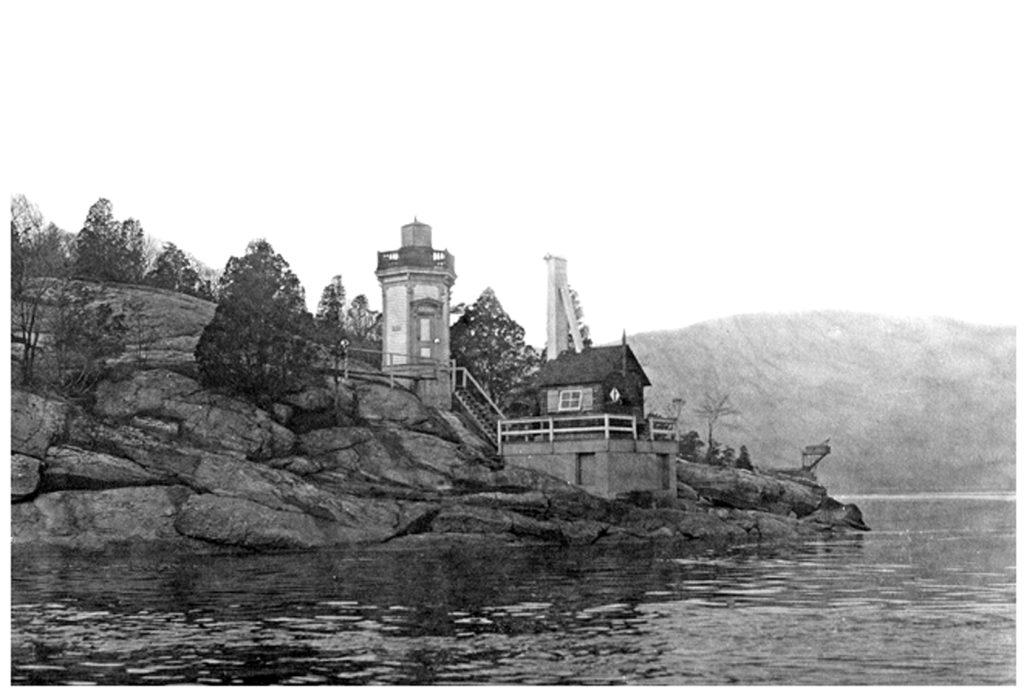
Approximately 40 miles north of the George Washington Bridge, the Hudson River narrows and zigzags sharply to the west and then back to the east. Projecting from the western side, Gees Point (=West Point), rises high above the river on a rocky cliff. A marsh lines the shoreline on the opposite side. At low tide, “The Two Brothers” rocks lurk just below the surface. During the late 18th and early 19th centuries, sailing vessels apparently ran aground all too frequently while making the dangerous turn. Recognizing the waterway’s serious risk, Congress, in 1848, appropriated $150 for the construction of a stake light at Gees Point. A 32-feet tall post was erected, equipped with small lenses. It became operational in 1853. However, John Ellis, the station’s first keeper, was paid merely as a lamplighter. During the winter, when the Hudson froze over, the beacon was extinguished. Ellis then occupied himself as a lumberjack and may even have harvested chunks of river ice that were stored for the warmer months.

It would not be until 1871 that another $1,500 was appropriated for the construction of an actual lighthouse. Completed the following year, the twenty-one-foot hexagonal wooden tower showed a fixed white light. Fourteen years later, a fog bell was installed at the site. Its automatic striking system required rewinding every four hours. During extended periods of fog, the keeper had to remain nearby, perhaps in the lighthouse tower, since the station was never provided with quarters.
The Revolutionary War brought to light the importance of Gees Point. In 1778, while the Hudson was frozen over, a unit of the Connecticut militia had crossed the river and set up camp on land now known as West Point. Fortifications were erected and during the following year, George Washington transferred his headquarters to the location. The fort became a vital site for defense against the British forces. Even earlier in the war, it had become obvious that the British forces intended to take control of the Hudson River, along with Lakes George and Champlain. With Manhattan already in British hands, they would then have been able to divide the colonies north and south of the waterways.
In 1876, to prevent British ships from access further north on the Hudson, a 1,800-feet-long chain was stretched across the river, near Fort Montgomery. Supported by log-rafts, the chain soon broke under its own weight and river current. Improvements were made to the chain barrier, but following the British capture of Fort Montgomery, a new 65-ton chain was produced and positioned across the river from Gees Point to Constitution Island. The “Great Chain,” supported on log rafts, prevented further British incursion on the Hudson. Successful battles on Lake Champlain also prevented British success from the north. Thirteen links of the “Great Chain” are on permanent display at West Point’s Trophy Point.
Following the establishment of a lighthouse at West Point, also called Gees Point and Old Crow’s Nest, the navigational aid served vessels that were negotiating the hazardous site. However, for its first keeper, John Ellis, and the ten others that followed him, the station could not have been a great assignment. Unlike most other light stations, there were no keeper’s quarters. They had to acquire a place of their own. In August of 1918, Keeper A. Phillip Anderson was notified that the Secretary of Commerce, on the third week of that month, intended to make a sail-by inspection of the lighthouse. The Secretary would do so while aboard the steamer Kilkenny. Lacking quarters at the lighthouse, Keeper Anderson remained on-site from Saturday the 10th through the 15th, but there was no sign of the Secretary. On the morning of August 16, the keeper left the station on an errand, aboard the U.S. Military Academy’s motorboat. However, just a short distance south of the lighthouse, he spotted the Kilkenny making its way up the Hudson. The motorboat pulled up next to the steamer where there was an exchange of greetings. However, the motorboat, being slow, could not make it back up to the station in time for the keeper to give the expected to salute as the Kilkenny passed by.
Two days later, as the steamer returned past the lighthouse, Anderson gave the proper salute. He was answered by the ship’s whistle. Standing on the deck, the Secretary also tipped his hat and the keeper responded in kind. However, despite his efforts, the Secretary was not satisfied. A short time later, the keeper was reprimanded by the Secretary for not having saluted the steamer as it traveled upriver. In defense of Keeper Anderson, the Third District Superintendent of Lighthouses J. Yates responded: “The keeper has no quarters at the station.” “Consequently, he cannot be at the station at all times.”
In 1894, it did not go as well for yet another West Point Lightkeeper, Joseph Miller. After Miller acted as the leader in a local political parade, residents complained about his actions. In his position, he had violated New York law. He was immediately removed from service for neglect of duty. His replacement, Joseph Elson, didn’t fare much better. The annual salary for keeping West Point Light was reduced from $600 to $300.
By the end of the Second World War, the stations’ lighthouse and bell tower were in poor condition. The Coast Guard demolished the structures and replaced them with a light tower. The current tower, “Light 39,” rises to 39 feet above the river. Though throughout its existence, the light at Gees Point (West Point) has contributed to the safety of vessels navigating the Hudson, the site was of even greater importance in our Nation’s history.
